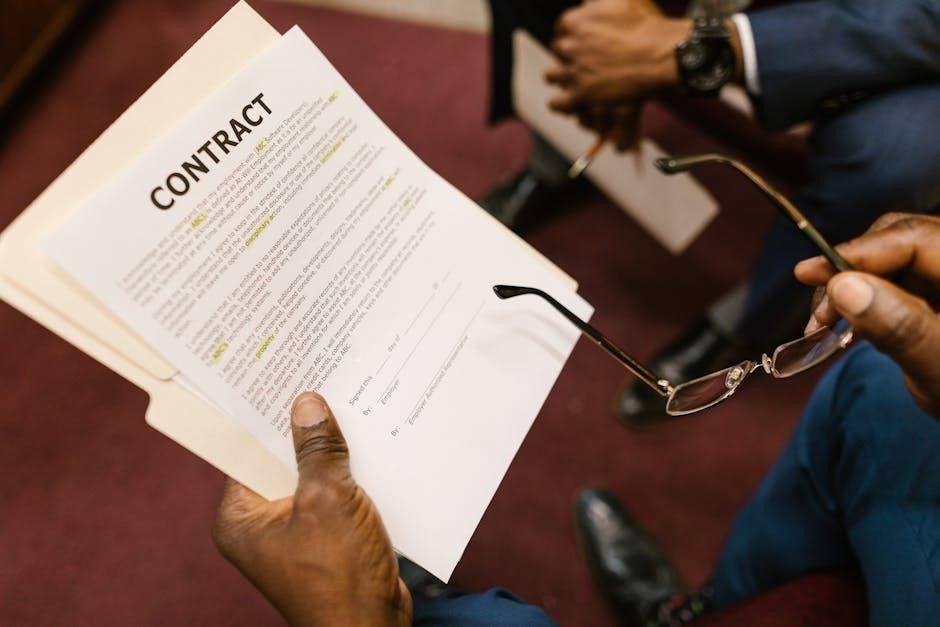
sample hold harmless agreement pdf
A Hold Harmless Agreement is a legal contract protecting one party from liability for damages or injuries. Essential for risk mitigation‚ it’s widely used in construction‚ events‚ and services. Using a sample ensures compliance and clarity‚ safeguarding interests effectively.
Overview of Hold Harmless Agreements
A Hold Harmless Agreement is a legal document that transfers liability from one party to another‚ protecting against potential lawsuits or claims. It is commonly used in construction‚ events‚ and service contracts to mitigate risks. This agreement ensures that one party (the indemnitor) agrees to protect another (the indemnitee) from legal liabilities arising from specific activities or circumstances. Available in broad‚ intermediate‚ or limited forms‚ it outlines the scope of indemnification and exceptions. Properly drafted‚ it provides clarity and compliance with local laws‚ safeguarding interests and preventing disputes. Essential elements include clear party identification‚ activity descriptions‚ and indemnification clauses. Using a sample ensures accuracy and enforceability‚ making it a vital tool for risk management in various professional and contractual settings.
Importance of Using a Sample Hold Harmless Agreement
Using a sample Hold Harmless Agreement ensures clarity‚ compliance‚ and protection for all parties involved. It provides a structured framework‚ reducing the risk of legal disputes and financial losses. A sample agreement helps avoid common mistakes‚ such as vague language or missing clauses‚ which can lead to enforcement issues. By following a proven template‚ individuals and businesses can save time and resources while ensuring the document aligns with legal standards. Additionally‚ a sample agreement offers customization options‚ allowing it to be tailored to specific situations‚ such as construction projects or special events. This makes it a practical and efficient tool for safeguarding interests and minimizing liability risks in various professional and contractual contexts.

Definition and Purpose
A Hold Harmless Agreement is a legal contract transferring liability from one party to another‚ protecting against claims or losses. Its purpose is to legally safeguard interests and minimize risks in various activities or transactions‚ ensuring one party is not held responsible for damages or injuries incurred by another. This agreement is essential for clarifying liability and providing peace of mind for all involved.
What is a Hold Harmless Agreement?
A Hold Harmless Agreement is a legal document where one party (the indemnitor) agrees to protect another party (the indemnitee) from liability‚ damages‚ or claims arising from specific activities or events. This agreement transfers the risk of legal responsibility from the indemnitee to the indemnitor‚ ensuring the indemnitee is not held legally or financially responsible for injuries‚ losses‚ or damages incurred by the indemnitor or third parties. It is commonly used in construction‚ events‚ and service contracts to mitigate risks and provide legal protection. The agreement outlines the scope of activities covered and the extent of indemnification‚ making it a crucial tool for safeguarding interests in high-risk scenarios. Properly executed‚ it becomes a legally binding contract‚ offering peace of mind and financial security for all parties involved.
Purpose and Function in Legal Contexts
The primary purpose of a Hold Harmless Agreement is to allocate and manage risk between parties‚ providing legal protection by transferring liability from one party to another. This agreement functions as a proactive measure to prevent legal disputes‚ ensuring that one party (the indemnitee) is shielded from claims‚ losses‚ or damages arising from specific activities or events. It is widely recognized in legal contexts for its ability to indemnify and protect against potential liabilities‚ making it essential in high-risk industries such as construction‚ event planning‚ and service contracts. By clearly defining the scope of indemnification and the parties involved‚ the agreement ensures that legal responsibilities are established beforehand‚ offering a structured approach to liability management and conflict resolution. Its enforceability varies by jurisdiction‚ emphasizing the importance of tailoring the agreement to comply with local laws and regulations.

Types of Hold Harmless Agreements
Broad Form‚ Intermediate Form‚ and Limited Form agreements differ in liability scope‚ with Broad Form transferring all liability‚ Intermediate Form covering only specific actions‚ and Limited Form applying proportionally.
Broad Form Agreement
A Broad Form Agreement is the most comprehensive type of Hold Harmless Agreement‚ transferring all liability from the indemnitee to the indemnitor‚ regardless of fault. It provides the highest level of protection‚ often used in high-risk scenarios like construction or large-scale events. This form indemnifies the indemnitee against all claims‚ losses‚ or damages arising from the specified activities. The indemnitor assumes full responsibility‚ even if the indemnitee is partially at fault. However‚ it excludes cases of gross negligence or willful misconduct. Broad form agreements are favored in situations where absolute protection is critical‚ but their enforceability varies by jurisdiction due to differing state laws. Legal consultation is recommended to ensure compliance and enforceability. This form is ideal for entities seeking maximum liability protection in risky operations or contracts.
Intermediate Form Agreement
An Intermediate Form Agreement balances liability between parties‚ holding the indemnitor responsible only for damages resulting from their own actions or negligence. It protects the indemnitee from claims arising from the indemnitor’s conduct but does not extend to third-party actions or the indemnitee’s own negligence. This form is commonly used in service contracts‚ rental agreements‚ and moderate-risk activities where shared responsibility is appropriate. It ensures the indemnitor is liable only for their direct involvement‚ offering a fair and balanced approach. Unlike the broad form‚ it does not provide blanket protection‚ making it more enforceable across jurisdictions. Legal experts often recommend this form for its clarity and balanced liability allocation‚ ensuring both parties understand their obligations and limitations. It is a practical choice for transactions requiring mutual accountability without excessive risk transfer.
Limited Form Agreement
A Limited Form Agreement provides restricted liability protection‚ holding the indemnitor responsible only for damages proportional to their fault. It is less protective than broad or intermediate forms‚ as it does not absolve the indemnitee entirely. This type of agreement is often used in low-risk scenarios or when shared responsibility is more appropriate. It ensures that liability is distributed fairly‚ reflecting the actual contribution of each party to the harm. The limited form is more likely to be enforceable across jurisdictions due to its balanced approach. However‚ it offers less comprehensive protection‚ making it unsuitable for high-risk activities. Legal experts recommend this form when limited liability is acceptable and aligns with the specific needs of the parties involved. It is a practical choice for transactions requiring proportional accountability without excessive risk transfer.

When to Use a Hold Harmless Agreement
Use a Hold Harmless Agreement in scenarios involving potential risks‚ such as construction projects‚ special events‚ or service contracts‚ to protect against legal liability and financial loss.
In Construction Projects
In construction projects‚ a Hold Harmless Agreement is crucial to protect contractors‚ subcontractors‚ and property owners from liability arising from accidents or property damage. This agreement ensures that one party agrees not to hold another liable for potential risks associated with the project‚ such as injuries to workers or damage to the property.
Such agreements are often tailored to the specific scope of the construction work‚ outlining the responsibilities and liabilities of all parties involved. They are essential for ensuring compliance with local regulations and for mitigating financial risks in high-stakes construction environments. By signing this agreement‚ all parties can proceed with confidence‚ knowing their interests are legally protected.
For Special Events
A Hold Harmless Agreement is frequently used in organizing special events‚ such as weddings‚ festivals‚ or corporate gatherings. These events often involve third-party vendors‚ attendees‚ and activities that carry inherent risks‚ making liability a significant concern.
By incorporating a Hold Harmless Agreement‚ event organizers and venue owners can protect themselves from potential lawsuits arising from accidents‚ property damage‚ or injuries during the event. This legal document ensures that the indemnitor agrees to cover liabilities‚ allowing the indemnitee to focus on hosting a successful event without financial risks. It is a practical solution for safeguarding against unforeseen circumstances and ensuring a smooth experience for all parties involved in the event. Properly drafted agreements are essential to avoid legal complications and financial losses.
In Service Contracts
A Hold Harmless Agreement is often incorporated into service contracts to protect providers from liability for damages or injuries arising from their services. This legal document is essential in industries like consulting‚ construction‚ and maintenance‚ where inherent risks exist. By signing the agreement‚ clients acknowledge that they will not hold the service provider responsible for specific risks‚ ensuring the provider operates without fear of legal repercussions.
The agreement clarifies liability‚ benefiting both parties by preventing disputes. It allows service providers to focus on delivering their services without legal concerns‚ safeguarding their interests and ensuring smooth business operations. A well-drafted Hold Harmless Agreement is crucial for protecting all parties involved in service contracts.

How to Create a Hold Harmless Agreement
To create a Hold Harmless Agreement‚ identify the parties‚ outline the scope of activities‚ and define indemnification terms. Ensure legal compliance and seek professional review for accuracy.
Step-by-Step Guide to Drafting
Drafting a Hold Harmless Agreement involves several key steps. First‚ clearly identify the parties involved‚ including their names‚ addresses‚ and roles. Next‚ outline the scope of activities or services covered by the agreement. Define the indemnification clauses‚ specifying the extent of liability protection. Include the term of the agreement‚ such as its effective date and duration. Specify the governing law and jurisdiction for legal disputes. Ensure compliance with local laws and regulations. Consider consulting a legal professional to review the document for accuracy and enforceability. Finally‚ have all parties sign and date the agreement‚ with witnesses if required‚ to validate its legal standing; This structured approach ensures clarity and protection for all involved.
Do’s and Don’ts When Creating
When creating a Hold Harmless Agreement‚ ensure clarity and specificity. Do clearly identify all parties involved‚ including their names and addresses. Do outline the scope of activities or services covered in detail. Do include indemnification clauses that specify the extent of liability protection. Do define the term of the agreement‚ such as its effective date and duration. Do consult a legal professional to ensure compliance with local laws. On the other hand‚ don’t use vague language that could lead to misinterpretation. Don’t omit critical details like governing law or jurisdiction. Don’t neglect to have the agreement reviewed by a legal expert for enforceability. By following these guidelines‚ you can create a robust and legally sound document that protects all parties involved.
Ensuring Legal Compliance
Ensuring legal compliance is crucial when drafting a Hold Harmless Agreement. Governing law provisions must be included to specify which state’s laws will apply. This is essential for resolving disputes and ensuring enforceability. The agreement should also comply with local‚ state‚ and federal regulations. Consulting a legal expert is recommended to verify that the document adheres to jurisdictional requirements. Additionally‚ the agreement must include clear indemnification clauses that align with legal standards. It’s important to avoid provisions that may be deemed unenforceable‚ such as clauses that protect against gross negligence. Proper execution‚ including signatures and witnesses‚ is necessary for the agreement to be legally binding. By addressing these factors‚ you ensure the document is compliant and offers the intended protection. Always review and update the agreement to reflect changes in laws or regulations. This step ensures ongoing compliance and validity.

Key Components of the Agreement
A Hold Harmless Agreement must include the parties involved‚ a clear scope of activities‚ indemnification clauses‚ and a governing law provision. Signatures are also required for validity.
Parties Involved
A Hold Harmless Agreement clearly identifies the two primary parties: the Indemnitee (the party being protected) and the Indemnitor (the party assuming liability). The Indemnitee is the individual or entity that seeks protection from potential claims or damages arising from specific activities or events. Conversely‚ the Indemnitor agrees to hold the Indemnitee harmless‚ taking on the responsibility of covering losses‚ damages‚ or legal expenses. Both parties must be explicitly named with their full legal names and addresses to avoid ambiguity. This clear designation ensures that the agreement is enforceable and leaves no room for misinterpretation. Proper identification of the parties involved is essential to the validity and effectiveness of the contract‚ as it outlines the scope of liability transfer and protection. Signatures from both parties are typically required to finalize the agreement.
Scope of Activities Covered
The Scope of Activities Covered in a Hold Harmless Agreement outlines the specific actions‚ events‚ or projects to which the indemnification applies. This section ensures clarity by detailing the exact nature of the tasks or circumstances covered‚ preventing disputes over the agreement’s applicability. It is crucial to define these activities precisely‚ avoiding vague terms that could lead to misinterpretation. For example‚ the agreement might cover a construction project‚ a special event‚ or a service contract‚ specifying the duration and location. Properly defining the scope ensures both parties understand the limits of liability transfer and protection. This clarity is essential for enforcing the agreement and ensuring it aligns with the intended purpose of protecting one party from potential risks. Ambiguity in this section can undermine the agreement’s effectiveness‚ making it a critical component to draft carefully.
Indemnification Clauses
Indemnification Clauses are central to a Hold Harmless Agreement‚ outlining the extent of liability protection. These clauses specify that one party (the indemnitor) agrees to compensate and defend another (the indemnitee) against claims‚ losses‚ or damages arising from specific activities or events. They define the scope of legal and financial protection‚ ensuring the indemnitee is not held responsible for certain risks. Such clauses are customizable‚ varying in breadth from limited to broad coverage‚ depending on the agreement’s terms. Clarity in drafting these clauses is critical to avoid disputes and ensure enforceability. Properly structured indemnification clauses provide clear guidelines on liability allocation‚ safeguarding the indemnitee’s interests while establishing the indemnitor’s obligations. This section is vital for defining the legal protections and responsibilities of both parties involved.

Legal Considerations
Legal considerations are crucial when drafting a hold harmless agreement. Enforceability varies by jurisdiction‚ and governing law clauses ensure compliance with state regulations. Consult legal counsel.
Enforceability Across Jurisdictions
The enforceability of a hold harmless agreement varies across jurisdictions due to differing state laws and interpretations. Some states enforce such agreements broadly‚ while others impose restrictions‚ particularly for gross negligence or willful misconduct. The language and scope of the agreement play a significant role in its enforceability. Courts often examine whether the agreement clearly outlines the parties’ intent and complies with local legal standards. Additionally‚ public policy considerations may affect enforceability‚ as courts may void agreements deemed unfair or against public interest. It is crucial to tailor the agreement to the governing jurisdiction and ensure compliance with local regulations to maximize its legal effectiveness. Consulting legal counsel is advisable to navigate these complexities successfully.
Governing Law and Jurisdiction
A hold harmless agreement must specify the governing law and jurisdiction to resolve disputes. This clause ensures clarity on which state’s laws will apply and where legal proceedings will occur. Including this detail prevents conflicts over jurisdictional issues. The agreement typically states that disputes arising from it will be governed by the laws of a specific state and resolved in its courts. This provision is crucial for enforcing the agreement‚ as it eliminates ambiguity about legal standards and procedural rules. Legal counsel often recommends tailoring this clause to align with the parties’ locations or business operations‚ ensuring compliance with local laws and facilitating smoother dispute resolution. Properly drafted‚ this clause enhances the agreement’s enforceability and provides a clear framework for addressing potential legal issues.
State laws significantly influence the enforceability and interpretation of hold harmless agreements. Each state has unique legal standards‚ affecting the validity and scope of such agreements. For instance‚ some states enforce broad form agreements without restrictions‚ while others limit their applicability or void them under certain conditions. Additionally‚ jurisdictions differ in how they treat indemnification for gross negligence or willful misconduct. It is essential to tailor the agreement to comply with the governing state’s laws‚ as non-compliance can render the agreement unenforceable. Consulting legal counsel familiar with local regulations ensures the document adheres to specific requirements‚ maximizing its protective value. Variations in state laws underscore the importance of customization to avoid legal challenges and ensure the agreement remains a robust safeguard for all parties involved. Proper drafting aligns with regional legal frameworks‚ guaranteeing the agreement’s effectiveness and enforceability across jurisdictions. Common mistakes include incorrect party identification‚ unclear activity descriptions‚ and omitting key details like jurisdiction or consideration. Ensuring clarity and specificity prevents legal disputes and ensures enforceability. One of the most critical mistakes in a Hold Harmless Agreement is the incorrect or ambiguous identification of the parties involved. This can lead to legal disputes and render the agreement unenforceable. Proper identification requires the full legal names‚ official titles‚ and addresses of both the indemnitor (the party assuming liability) and the indemnitee (the party being protected). Using nicknames‚ incomplete names‚ or incorrect addresses can create confusion and undermine the agreement’s validity. For example‚ failing to specify whether a party is an individual or a business entity can lead to misunderstandings. To avoid this‚ ensure all parties are clearly and accurately identified‚ with their official capacities stated if applicable. This clarity is essential for the agreement to hold up in court and provide the intended legal protection. Consulting a legal expert can help prevent such errors and ensure compliance with legal standards. Unclear activity descriptions in a Hold Harmless Agreement can lead to ambiguity and potential disputes. Vague terms‚ such as “various services” or “general activities‚” may fail to specify the exact scope of the agreement‚ making it difficult to enforce. For instance‚ if the agreement does not clearly define the nature of the event or project‚ it may leave room for interpretations that could harm one or both parties. To avoid this‚ the activities covered should be described in detail‚ including the type‚ location‚ and duration. For example‚ instead of stating “lawn maintenance‚” specify “lawn mowing‚ trimming‚ and edging on the property at 123 Main Street.” Clear descriptions ensure both parties understand their responsibilities and liabilities‚ reducing the risk of legal challenges. Precision is key to a legally sound agreement. A Hold Harmless Agreement is a vital tool for protecting against liability. Properly drafted‚ it ensures clarity and safeguards all parties involved‚ minimizing legal disputes effectively. A Hold Harmless Agreement is a legal document that transfers liability from one party to another‚ protecting against potential lawsuits or claims. It is commonly used in construction‚ events‚ and service contracts to mitigate risks. The agreement defines the parties involved‚ the scope of activities‚ and indemnification clauses. Proper drafting ensures legal compliance and avoids disputes. Key components include clear identification of indemnitor and indemnitee‚ detailed activity descriptions‚ and governing law specifications. Different types‚ such as broad‚ intermediate‚ and limited forms‚ cater to varying situations. Avoiding mistakes like incorrect party identification and vague descriptions is crucial. Consulting legal experts ensures enforceability and compliance with state laws‚ making it an essential tool for safeguarding interests in high-risk scenarios. Implementing a Hold Harmless Agreement requires careful attention to detail to ensure its validity and effectiveness. Proper execution involves clear identification of all parties‚ precise descriptions of covered activities‚ and adherence to local laws. Ensuring legal compliance is crucial‚ as enforceability varies by jurisdiction. Consulting a legal expert is recommended to tailor the agreement to specific needs and avoid potential pitfalls. Both parties should fully understand their obligations before signing‚ as the agreement binds them legally. Regular reviews of the document are essential to maintain relevance and compliance with changing regulations. By following these steps‚ individuals and organizations can effectively mitigate risks and protect their interests in various scenarios‚ ensuring peace of mind and legal security. Explore Hold Harmless Agreement templates and guides for state-specific requirements. Visit websites like formsandfiling.com for customizable templates and detailed instructions to streamline your process effectively. For drafting a Hold Harmless Agreement‚ using a reliable template is essential. Websites like formsandfiling.com offer customizable‚ state-specific templates designed to meet legal requirements. These templates are tailored for various scenarios‚ such as construction projects‚ special events‚ or service contracts. They include essential clauses like indemnification‚ scope of activities‚ and governing law. By using a pre-designed template‚ you ensure compliance with local laws and avoid common drafting errors. Additionally‚ many platforms provide step-by-step guides to help you fill out the form accurately. Ensure the template you choose is updated to reflect current legal standards and suits your specific needs. This approach saves time and provides peace of mind‚ knowing your agreement is legally sound and enforceable. For a deeper understanding of Hold Harmless Agreements‚ explore resources like formsandfiling.com‚ offering detailed guides and state-specific templates. Legal websites provide insights into drafting and enforcing such agreements‚ ensuring compliance with local laws. Additionally‚ consulting legal experts can clarify nuances and prevent common mistakes. References from reputable sources‚ such as legal journals and state bar associations‚ offer comprehensive overviews of indemnification principles and jurisdictional variations. These materials are invaluable for ensuring your agreement is both legally sound and tailored to your specific needs. By leveraging these resources‚ you can create a robust and enforceable Hold Harmless Agreement that protects all parties involved effectively.Variations in State Laws

Common Mistakes to Avoid
Incorrect Identification of Parties

Unclear Activity Descriptions
Final Thoughts on Implementation

Additional Resources
Recommended Templates
Further Reading and References